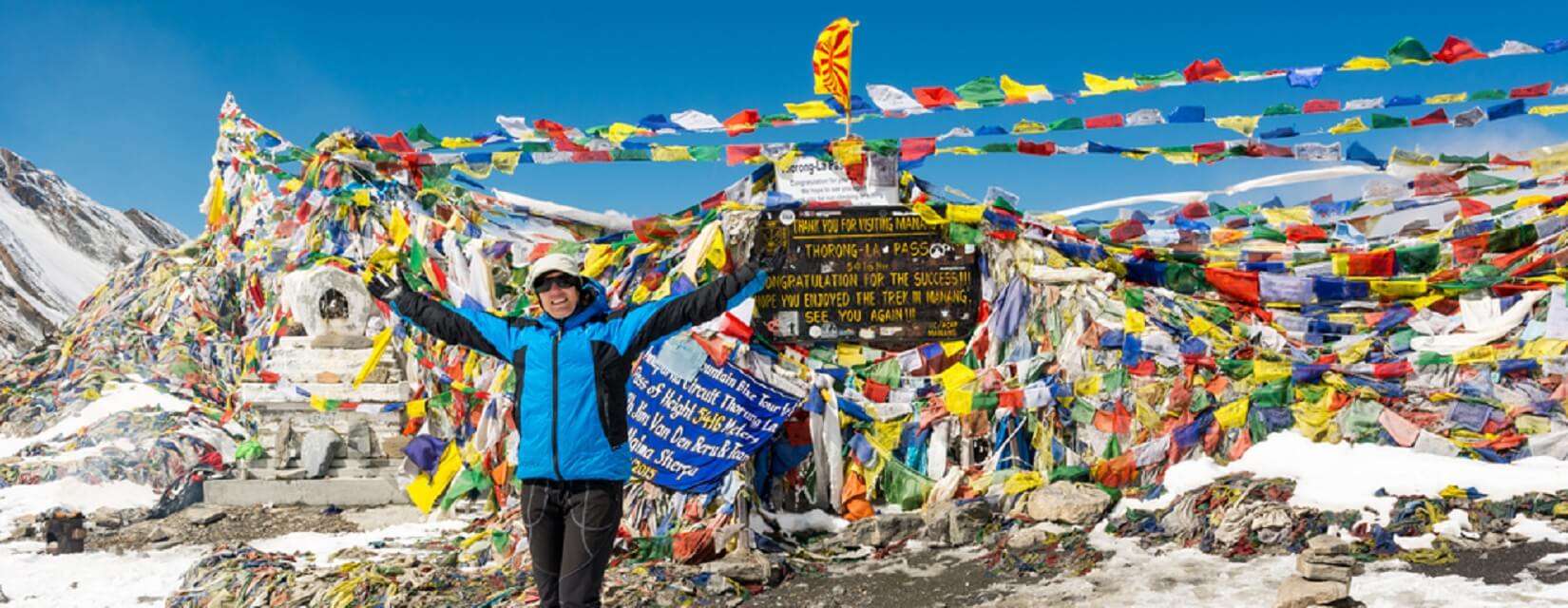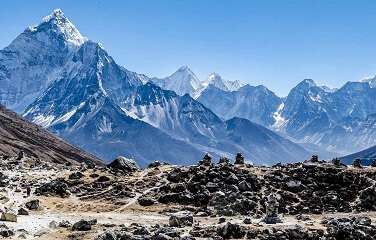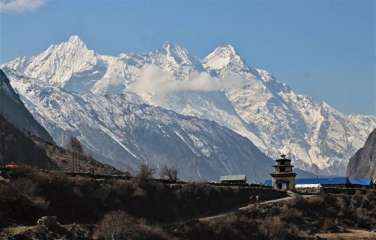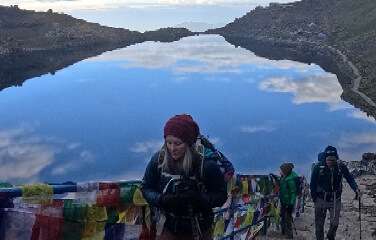Overview of the Annapurna Circuit

The Annapurna Circuit is a long-distance trek within the Annapurna mountain range of central Nepal. The total length of the trek varies between 160-230 kilometers (100-145 miles), depending on the starting and ending points and whether you choose to use transportation in certain sections. The trek generally takes about 15-20 days to complete and includes several significant milestones, such as Thorong La Pass, which at 5,416 meters (17,769 feet) is one of the highest trekking passes in the world.
Starting Point and Route
Most trekkers start the Annapurna Circuit at Besisahar, a small town accessible by road from Kathmandu or Pokhara. The route follows the Marsyangdi River valley, passing through villages, terraced fields, and dense forests. As trekkers ascend, the landscape changes dramatically from lush green hills to arid, high-altitude terrain.
Key stops along the route include:
- Besisahar: The traditional starting point of the trek, where trekkers can hire guides and porters, stock up on supplies, and get permits.
- Chame: The district headquarters of Manang, offering stunning views of Annapurna II and Lamjung Himal.
- Manang: A popular acclimatization stop with several side trips, including the Gangapurna Lake and the Ice Lake.
- Thorong La Pass: The highest point of the trek, offering breathtaking views of the surrounding peaks.
- Muktinath: A sacred pilgrimage site for Hindus and Buddhists, located on the other side of Thorong La Pass.
- Jomsom: A town in the Kali Gandaki Valley, where trekkers often conclude the trek or continue to the Annapurna Sanctuary or Ghorepani Poon Hill.
Cultural Diversity

The Annapurna Circuit is not just a journey through stunning landscapes; it is also a journey through diverse cultures and traditions. The lower regions are predominantly inhabited by Hindu communities, while the higher regions are home to Tibetan Buddhist communities. Trekkers will encounter a mix of cultures, with opportunities to visit monasteries, gompas, and chortens, and participate in local festivals.
- Hindu Villages: In the lower regions, villages like Besisahar and Tal have a predominantly Hindu population. Temples and shrines dot the landscape, and the agricultural lifestyle dominates.
- Buddhist Influence: As trekkers ascend, the influence of Tibetan Buddhism becomes more prominent. Villages like Manang and Braga are rich in Buddhist culture, with ancient monasteries and prayer flags fluttering in the wind.
Natural Beauty and Biodiversity
The Annapurna region is a biodiversity hotspot, home to numerous plant and animal species. The trek takes you through a variety of ecosystems, each with its unique flora and fauna.
- Subtropical Forests: The lower regions are covered in dense forests of rhododendron, oak, and pine. These forests are home to a variety of wildlife, including monkeys, deer, and numerous bird species.
- Alpine Meadows: As you ascend, the forests give way to alpine meadows, where yaks and blue sheep graze. The meadows are dotted with wildflowers, making for a picturesque landscape.
- High-Altitude Deserts: The region around Thorong La Pass and Muktinath is a high-altitude desert, characterized by barren, rocky terrain and sparse vegetation. Despite the harsh conditions, this area supports a variety of hardy plant and animal species.
Challenges and Acclimatization

The Annapurna Circuit is a challenging trek, requiring a good level of fitness and proper acclimatization to avoid altitude sickness. The trek involves significant altitude gain, with several sections above 3,000 meters (9,842 feet).
- Acclimatization Days: It is essential to include acclimatization days in your itinerary to allow your body to adjust to the high altitude. Manang is a popular acclimatization stop, with several short hikes to higher elevations.
- Physical Preparation: Prior physical training, including cardiovascular exercises and strength training, is recommended to prepare for the trek's demands.
Permits and Regulations
To trek the Annapurna Circuit, you need two permits:
- Annapurna Conservation Area Permit (ACAP): Required for entry into the Annapurna Conservation Area, which covers the entire trekking route.
- Trekkers' Information Management System (TIMS) Card: This card is used to keep track of trekkers and ensure their safety.
Permits can be obtained in Kathmandu or Pokhara before starting the trek.
Accommodation and Food
The Annapurna Circuit offers a range of accommodation options, from basic teahouses to more comfortable lodges. Teahouses are simple, family-run establishments that provide beds and meals.
- Teahouses: Found in every village along the trek, offering basic amenities such as a bed, shared bathroom, and a common dining area.
- Lodges: More comfortable than teahouses, with private rooms, attached bathrooms, and a wider variety of meals.
Meals are typically hearty and carb-heavy to provide the necessary energy for trekking. Common dishes include dal bhat (rice with lentil soup), momos (dumplings), noodles, and pancakes.
Best Time to Trek

The best time to trek the Annapurna Circuit is during the pre-monsoon (March to May) and post-monsoon (September to November) seasons.
- Pre-Monsoon: The weather is generally stable, with clear skies and moderate temperatures. The rhododendron forests are in full bloom, adding vibrant colors to the landscape.
- Post-Monsoon: The skies are clear, offering spectacular mountain views. The weather is cooler, especially at higher altitudes, but the trails are less crowded.
Environmental and Social Responsibility
Trekking in the Annapurna region comes with a responsibility to minimize your environmental impact and respect local cultures.
- Leave No Trace: Follow the principles of Leave No Trace, including packing out all trash, avoiding single-use plastics, and staying on designated trails.
- Respect Local Cultures: Be mindful of local customs and traditions. Dress modestly, ask for permission before taking photos of people, and support local businesses by purchasing goods and services directly from the community.
Tilicho Lake: A Hidden Gem in the Annapurna Region

Nestled in the heart of the Annapurna region, Tilicho Lake stands as one of the highest lakes in the world, perched at an elevation of 4,919 meters (16,138 feet). This pristine, turquoise lake, surrounded by towering snow-capped peaks, is a breathtaking destination for trekkers seeking both adventure and tranquility.
Location and Accessibility
Tilicho Lake is located in the Manang District of Nepal, within the Annapurna Conservation Area. The journey to Tilicho Lake typically begins in Besisahar, following the Annapurna Circuit trail. From Manang, a side trip leads trekkers to the lake, adding approximately 3-4 days to the overall trek.
Trekking Route to Tilicho Lake
The route to Tilicho Lake diverges from the main Annapurna Circuit at the village of Khangsar. Trekkers then proceed to Tilicho Base Camp, which serves as the staging ground for the final ascent to the lake. The trail from Tilicho Base Camp to the lake is challenging, involving steep ascents and potential exposure to high-altitude conditions.
Key stops along the route include:
- Khangsar: A traditional Gurung village, offering a glimpse into the local culture and lifestyle.
- Tilicho Base Camp: The last stop before reaching the lake, providing basic accommodation and meals for trekkers.
Natural Beauty and Scenic Views

Tilicho Lake's stunning beauty is a reward for the challenging trek. The lake's crystal-clear waters reflect the surrounding peaks, creating a mesmerizing sight. The towering walls of the Annapurna and Nilgiri ranges frame the lake, enhancing its serene and otherworldly atmosphere.
During the trek, trekkers pass through diverse landscapes, including lush forests, alpine meadows, and rocky terrain. The changing scenery adds to the trek's appeal, offering new vistas at every turn.
Wildlife and Flora
The area around Tilicho Lake is rich in biodiversity. Trekkers may encounter various wildlife species, such as blue sheep, Himalayan thar, and the elusive snow leopard. The flora changes with altitude, ranging from rhododendrons and pine forests in the lower regions to alpine shrubs and grasses near the lake.
Cultural Experience

While the primary draw of Tilicho Lake is its natural beauty, the cultural experiences along the way are equally enriching. The trek passes through several traditional villages, where trekkers can interact with local communities and learn about their customs and traditions. The monasteries and chortens along the route offer a glimpse into the region's spiritual heritage.
Preparation and Safety
Trekking to Tilicho Lake requires good physical fitness and proper acclimatization due to the high altitude. It is essential to include rest days in the itinerary and ascend gradually to minimize the risk of altitude sickness. Trekkers should also carry appropriate gear, including warm clothing, sturdy footwear, and trekking poles.
Conclusion
The Annapurna Circuit is more than just a trek; it is an unforgettable journey through some of the most stunning landscapes and rich cultures in Nepal. Whether you are a seasoned trekker or a first-time adventurer, the Annapurna Circuit offers a unique and rewarding experience that will leave you with lasting memories. Prepare well, and respect the environment and local cultures, and you will undoubtedly find yourself captivated by the beauty and magic of the Annapurna region.
Tilicho Lake is a hidden gem in the Annapurna region, offering a perfect blend of natural beauty, adventure, and cultural experiences. The journey to the lake is challenging but immensely rewarding, with the stunning views and serene environment making it a trekker's paradise. For those seeking an unforgettable trekking experience in Nepal, Tilicho Lake is a must-visit destination.





